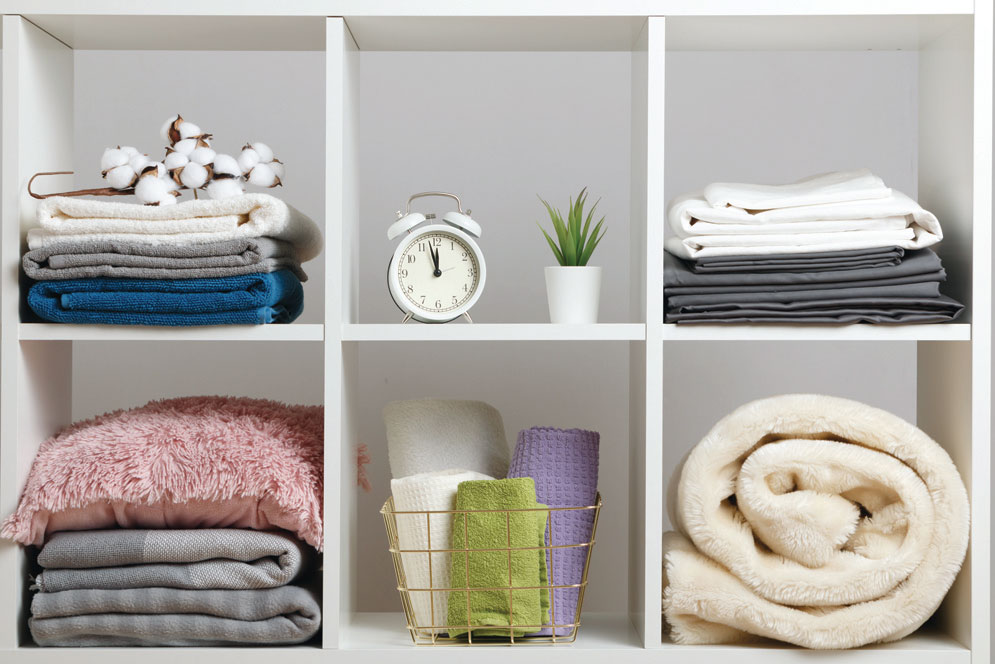
Time for a Declutter
by Melva Burton
This is the time of year our thoughts often turn to spring cleaning. But why don’t we have a tradition of winter cleaning or autumn cleaning?
The ritual at this particular point has its links back to Victorian times when, after a winter of burning coal fires, there would be sooty layer on the windows, walls and furniture. As the weather started to get warmer, women would be beating the carpets outside to get rid of the dust and grime as well as cleaning the rest of the house. Our modern version of spring cleaning often involves trips to charity shops and the tip as we have a clear out of all the ‘stuff ’ that has accumulated over the year and we pat ourselves on the back for having done a good tidy up. But we don’t always find it easy to chuck things out, do we? I have a stash of teenage diaries along with a box of my dad’s old 78 vinyl records and a pile of John Denver CDs that I am emotionally attached to. Overall, this isn’t a problem for me as this hoard doesn’t take up much space or get in the way of my daily life. However, there is a broad spectrum of hoarding behaviour ranging from light touch collecting through to more serious hoarding issues that present a range of health, safety and fire issues.
“It is now widely acknowledged that hoarding can be a mental health disorder linked to psychological and emotional issues.”
So why do we, like many other species of animals, hoard? Going back in time, for us humans, it can be linked to deprivation and scarcity. We don’t have to look far into our very recent history to find examples… panic buying fuel and loo rolls spring to mind. We have a tendency to stockpile foods, water and other essentials to see us through periods of shortage. Many of us were brought up by parents and grandparents who were wartime babies, and who hoarded to see them through periods of rationing and austerity.
In more recent times it has been recognised that the reasons for hoarding are far broader and more complex. Hoarding behaviour can be triggered by trauma, bereavement, loss, grief or poverty. It is now widely acknowledged that hoarding can be a mental health disorder linked to psychological and emotional issues.
Ivy has a way of creeping all over the place without being noticed until, suddenly, it has taken over.
Hoarding can be seen as a comfort blanket that helps us cope with life in the same way as gambling, over-eating or drinking can be. The suggestion is that between 2% and 5% of the UK population hoard. The wide range of things that hoarders collect varies but may include clothes, books, newspapers, post, containers, food and animals. Digital hoarding of emails, photos and files is also becoming more common. Hoarding doesn’t only affect the individual hoarder. It can impact on the wider family, friends and neighbours and strain relationships. It can be difficult for people who hoard to ask for help because of the shame and stigma associated with it, particularly because TV programmes about hoarding have tended to be more interested in increasing their ratings through sensationalising the issue.

In relation to hoarding, there is something called ‘clutter blindness’. People who hoard may become so accustomed to all the stuff around them that they don’t appear to see it, despite the fact that their life is negatively impacted by it. Jo Cooke, in her excellent book ‘Understanding Hoarding’, compares clutter to ivy. Ivy has a way of creeping all over the place without being noticed until, suddenly, it has taken over. She suggests a range of helpful decluttering techniques and tips that have proved to be very effective for people with hoarding behaviours. She also gives advice about how to help someone who hoards. She points out that suggesting an intense decluttering or forced clear-out session may not be a helpful way forward. Such an approach is recognised as being too radical and potentially traumatic for a person with hoarding difficulties who may feel lost without their clutter. They may quickly refill the space. Her view is that it is important to look at the person first and deal with the stuff second so that the person feels that they are being understood, respected and not judged.
Pendle Borough Council, concerned about the impact of extreme hoarding on individuals and the local community, is funding Colne Open Door to provide a support group for people with hoarding difficulties. Brad Twigg, a training CBT practitioner, and myself were asked to start the ball rolling and facilitate the sessions which we have done with great enthusiasm.
It takes a lot of courage for someone to make a decision to set an intention to do something about their hoarding behaviour
The Magpies group meets monthly on a Thursday evening for an hour and a half. The aims and objectives for the group were arrived at following conversations with the group members about what would help them move forward. Our focus is on the group being a safe and supportive place for people to share strategies about how to get rid of stuff and to gain new ideas and new ways of looking at hoarding as well as understanding why people hoard. It provides the space for members to share their thoughts with likeminded people, as well as providing an opportunity for them to step back and talk about their hoarding difficulties in a setting where they are not being judged. Peer support and friendship is very important. Each time we meet we start off by sharing current successes and challenges, followed by an input on a potentially helpful topic and then a discussion about it. For example, we have looked at motivation and the cycle of change as well as how taking a ‘mindful pause’ can help to settle the emotional feelings that arise when people think about decluttering. It takes a lot of courage for someone to make a decision to set an intention to do something about their hoarding behaviour and we want to make those tentative steps a bit easier and less scary.
Anyone wanting to know more about the Magpies group can contact Nick Alderson, the manager at Colne Open Door Centre (manager@opendoorcentre.org.uk or 01282 860342). The group will meet on Thursday 31st March at 6pm then on the first Thursday of the month from May onwards.
Top 10 tips for a successful decluttering
- Acknowledge and identify the problem. Realising that the problem exists is often the first step.
- Tell someone you trust about the problem and ask for help. There are people and organisations that can give you the practical, psychological and emotional support you may require.
- Pick a spot. Identify an area in your home to clear. Small, achievable goals will help you to recognise the progress you are making
- Focus on it. Work on that one area consistently – at least once every day for a minimum of 15 minutes, gradually increasing the frequency and the time.
- Every second counts. Decide whether or not to keep an item within 10-20 seconds. Looking at, touching and thinking about an item is likely to increase your attachment to it.
- Create a timetable and stick to it. Schedule your clearing sessions for regular times each week/day.
- Recognise what you’ve achieved. Take “before and after” photos which will give you a real sense of pride as you progress. Reward yourself with something you enjoy but don’t use a shopping spree as a reward!
- Fleeting feeling. Remember that the bad feelings you experience when letting items go only last for a short while.
- Ask for support. Ask someone to help take things away immediately. This will avoid the risk of you changing your mind.
- Be aware. Be aware of situations when you might be tempted to acquire more items, such as in a particular shop or if the price is reduced.
Be prepared to resist temptation.

More information, support and advice about hoarding can be found at helpforhoarders.co.uk, hoardingdisordersuk.org and hoardershelpinghoarders.com




